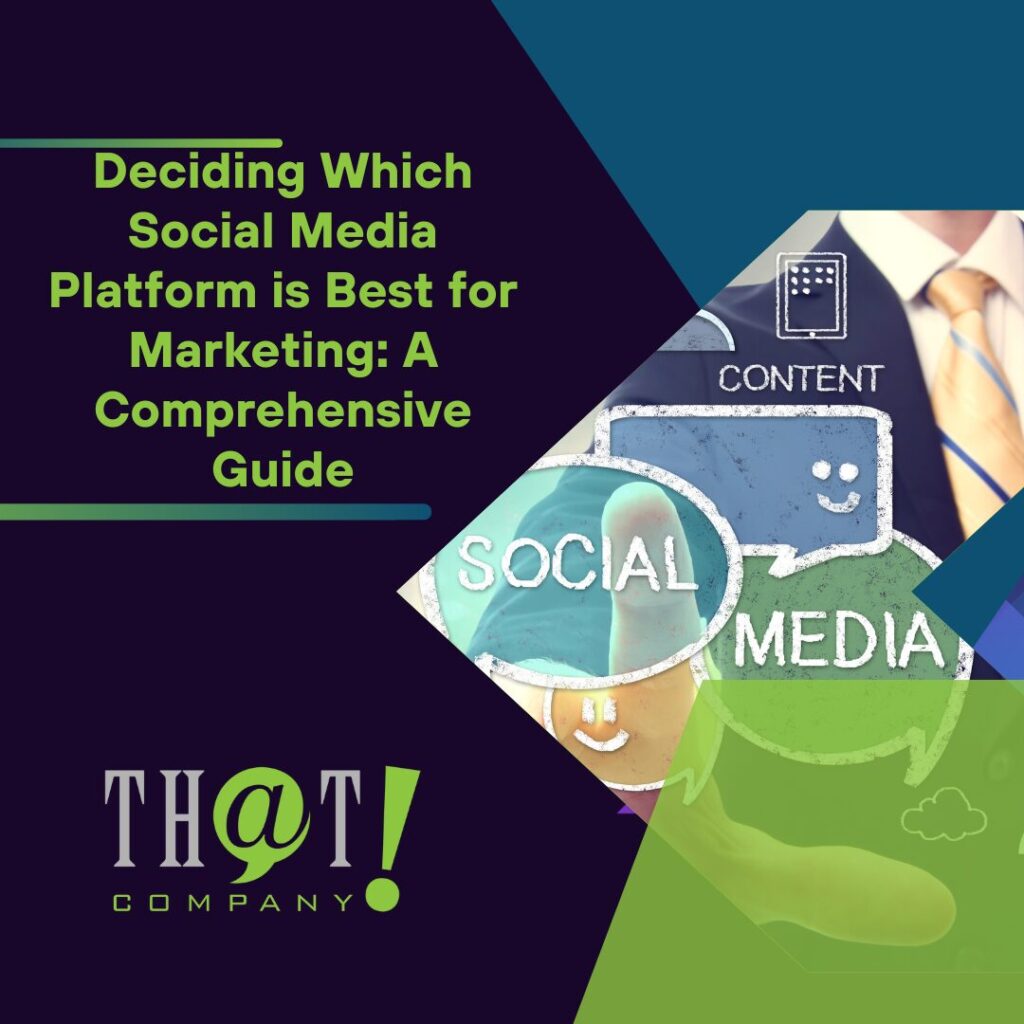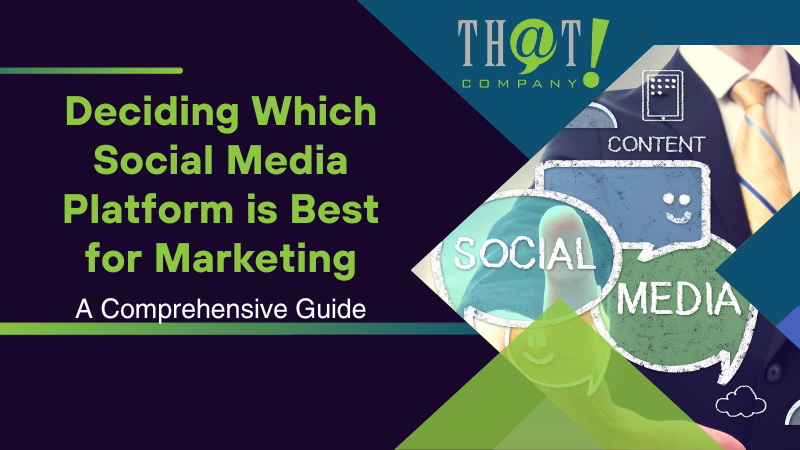
Marketers seeking the best social media platform for marketing want straightforward answers, not guesswork. This no-nonsense guide compares major platforms, examining user engagement, target demographics, and advertising effectiveness to answer the question: which social media platform is best for marketing? Whether you’re chasing high engagement rates or a platform with the best ROI, here’s where you’ll uncover the insights to strategically select your ideal social media platform for marketing in 2024.
Key Takeaways
- Understanding your target audience’s demographics, interests, and behaviors is fundamental to selecting the right social media platforms and tailoring engaging content that resonates with them.
- Each social media platform offers unique features and caters to specific user demographics, making the evaluation of these platforms based on marketing goals, user base, and advertising options essential for an effective marketing strategy.
- Key factors such as marketing objectives, budget, resources, and insights from competitor analysis are critical to guide the selection of the most suitable social media platforms for achieving marketing success.

Understanding Your Target Audience
Understanding your target audience is akin to knowing the North Star in the night sky, a fixed point to navigate the vast ocean of social media platforms. With a deeper understanding of your target audience, you can align your messaging more accurately to their needs, thus optimizing brand reach and achieving your marketing objectives.
But how do you gain this understanding? Tools like Emplifi and Feedly can be your reliable crew members. Emplifi, with its AI-powered analytics, can help you decipher the social media behavior of your target audience. On the other hand, Feedly aids in discovering and organizing content that resonates with your audience’s interests. With these tools at your disposal, you’re well-equipped to customize your social media marketing strategy and set sail toward your destination.
Demographics
As an explorer, you need to know the demographics of the islands you’re targeting. Regarding social media marketing platforms, demographics are pivotal in influencing your choice. For example, if your target audience is predominantly female, you might set your course towards the islands of:
- Snapchat
- TikTok
These platforms are popular among women.
Understanding demographics is not just about knowing the gender or age of your target audience. It’s about understanding the unique nuances of each platform’s user base. This insight can guide your journey, helping you engage with the right people, in the right way at the right time.
Interests and Behaviors
Now that you’ve charted your course, it’s time to pack your ship with the right content to engage your target audience. This brings us to another vital aspect of understanding your audience – their interests and behaviors. The better you understand your audience’s values, the more precisely you can tailor your content to their preferences.
For instance, some examples of interactive ad formats include:
- Instagram Shopping ads, which enable customers to gain direct insights into products, leveraging their visual interests
- Rich pins on Pinterest, which offer additional context to products or articles, catering to users’ preferences for detailed and visually captivating content
- Polling sticker ads on Instagram actively involve users in the content, providing valuable insights into their preferences and behaviors.
Understanding these behaviors and interests allows you to create a treasure trove of content that resonates with your audience and enhances your marketing activities.

Evaluating Social Media Platforms for Marketing
Having embarked on your journey, it’s time to look closely at the islands and the social media platforms. Each platform holds unique opportunities for marketers, and understanding their strengths and weaknesses is crucial for ensuring a successful marketing campaign.
To optimize your social media marketing strategy, you need to evaluate leading social media platforms based on their user base, features, and advertising options to determine the best social media platform for your needs. For instance, WeChat is an all-in-one platform with an impressive 1.3 billion monthly active users, primarily concentrated in China and Asia, making it crucial for engaging with the Asian market.
Meanwhile, platforms like Facebook and Instagram offer a range of social media ad options, such as Collection ads for a shoppable mobile experience, In-Feed ads to integrate with user content, and Follower ads to enhance account visibility. These diverse features make each platform a unique island, offering different opportunities for marketers.
Our first stop in this voyage is the island of Facebook. With over 3 billion monthly active users, Facebook is an exceptional social media site for social media marketing. Its features facilitate:
- User engagement through communication
- Group participation
- Business discovery
- Brand following
This makes it an ideal environment for lead generation and audience expansion through advertising.
The Facebook algorithm prioritizes content that stimulates conversations and meaningful interactions. Effective formats for driving engagement include:
- Text
- Images
- Video content
- Stories
Moreover, Facebook offers a range of social media advertising options, with image and video ads being especially beneficial for prominently showcasing products, services, and brands. Its sophisticated targeting capabilities ensure that ads are delivered to the most pertinent audience. All these factors make Facebook a popular destination for marketers.
Next, we sail towards the visually appealing island of Instagram. As a platform, Instagram is a paradise for businesses with visually attractive products that cater to a younger demographic. With a substantial one billion monthly active user base, Instagram provides an ideal platform to target a wide and diverse audience.
Instagram allows businesses to engage users by sharing a variety of content types, such as:
- Photos
- Videos
- Stories
- Reels
- Live videos
This provides a dynamic and interactive experience. Furthermore, an Instagram business profile provides comprehensive analytics for profile and post engagements, and the capability to target potential customers through Explore feed advertisements. These features make Instagram a captivating stopover for marketers on their social media marketing journey.
Our journey continues to the fast-paced island of Twitter. As a platform, Twitter enables users to share concise thoughts, and valuable information, and participate in conversations, making it an excellent destination for sharing news, and updates, and engaging with influencers.
Maintaining a regular presence on Twitter is crucial due to its widespread use as a platform for obtaining news and following brands and its role as an additional customer service channel for real-time audience engagement. Businesses can leverage Twitter’s range of ad products and audience targeting options, making it a cost-effective choice for marketing. With these features, Twitter proves to be a bustling marketplace for marketers.
The next stop on our voyage is the professional networking hub, LinkedIn. LinkedIn is an ideal platform for B2B marketing, lead generation, and fostering industry connections. Its precise targeting capabilities for professionals and businesses and its specialized features like personalized inbox ads and tools like Conversation Ads make it a unique destination for businesses.
With its ability to drive social media traffic to B2B company websites, accounting for 46% of such traffic, LinkedIn is highly effective in B2B marketing. Moreover, it serves as a platform for:
- networking with professionals
- identifying prospects
- disseminating industry insights
- presenting company culture
- cultivating personal brands
This makes LinkedIn a must-visit island for businesses focusing on B2B marketing.
Navigating towards the visual realm, we find ourselves on the island of Pinterest. A visual-oriented platform designed for product discovery and directing traffic to websites, Pinterest is particularly effective for marketing in the fashion industry due to its visual nature.
Strategies to increase website traffic through Pinterest include:
- Creation of specialized boards for blog posts
- Optimization of pin titles with relevant keywords
- Regular pinning
- Participation in group boards
- Development of original content tailored to Pinterest users
Additionally, Pinterest offers advertising options like Standard and Video Pin ads, enabling brands to effectively promote their products within the platform’s visual content streams. These features make Pinterest a visual paradise for marketers.
TikTok
Steering our ship towards the rapidly growing island of TikTok, we find a particularly popular platform among the younger demographic. With a substantial user base and the prevalence of short-form video content, TikTok is a significant platform for social media marketing.
The platform is primarily used for entertainment, with users predominantly sharing short videos such as viral dances, quick tutorials, and comedic skits. Moreover, TikTok provides advertising features for businesses to promote their products and services, offering the placement of both image and video ads, enabling marketers to reach their desired audience effectively. This makes TikTok a fun-filled destination for marketers targeting a younger demographic.
YouTube
Our final destination in this voyage is the video-sharing platform, YouTube. As the second largest search engine, YouTube presents considerable opportunities for video marketing. From sharing tutorials, company culture, and product demonstrations, YouTube offers a vast canvas for marketers to paint their brand story.
Strategies to enhance your YouTube channel for marketing include:
- Renaming video files with target keywords
- Naturally incorporating keywords in video titles
- Establishing a distinct brand identity for the channel
- Strategically using keywords in titles and descriptions
- Crafting compelling titles and descriptions
- Uploading appealing channel art
- Prioritizing audience engagement within the initial 15 seconds of videos
Implementing these strategies can help improve the performance of your YouTube channel for marketing purposes.
Furthermore, the types of content that perform well on YouTube for marketing purposes include:
- How-to guides and tutorials
- Product reviews
- Unboxings
- Educational videos
This makes YouTube a must-visit island for businesses focusing on video marketing.
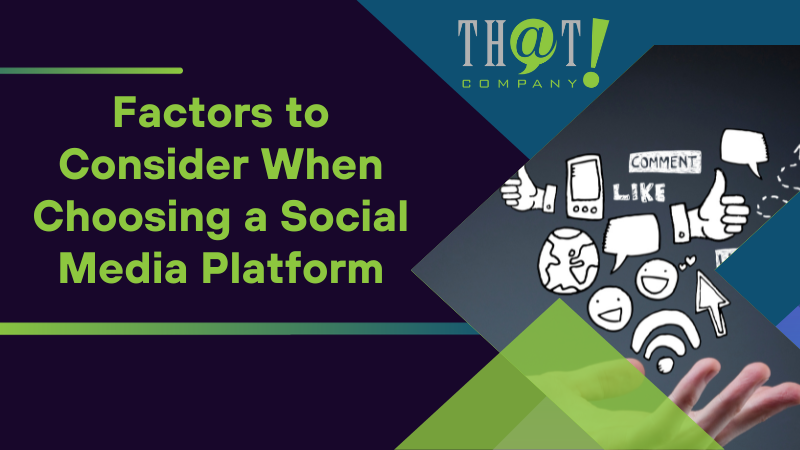
Factors to Consider When Choosing a Social Media Platform
As we conclude our voyage across the social media ocean, it’s time to reflect on the journey and consider the factors that will guide your choice of islands – the social media platforms. Identifying your marketing objectives, understanding your budget and resources, and conducting a competitor analysis are crucial steps in this process.
These factors are like a compass, guiding you toward your destination – the perfect social media marketing strategy. Understanding these factors will set you on the right course, ensuring that your voyage in the vast ocean of social media marketing is successful and rewarding.
Goals and Objectives
Just as a ship needs a destination to sail towards, your social media marketing strategy needs clear goals and objectives. Aligning these goals and objectives with the features and user base of your chosen platform can enhance the overall effectiveness of your social media marketing efforts.
Platforms like Facebook and LinkedIn are ideal for brand awareness and direct customer connection, while others serve specific needs such as content sharing, audience engagement, sales growth, and lead generation. Recognizing these objectives will steer you toward the most beneficial social media marketing platform in social media marketing.
Budget and Resources
As we know, every voyage requires resources. The constraints of your budget will influence the social media platform you can afford for marketing, affecting content creation, advertising spending, and the extent of social strategies that can be implemented.
Whether you’re a small business owner just starting your journey or a seasoned explorer with a larger budget, assessing your resources is crucial before setting sail. By considering your budget and resources, you can ensure that your chosen platform is cost-effective and manageable, allowing you to navigate the social media seas easily.
Competitor Analysis
As explorers would study previous expeditions, conducting a competitor analysis is crucial for identifying opportunities and gaps in your strategy. It gives you insights into your competitors’ successes and failures, allowing you to customize your approach and gain a competitive advantage on a suitable social media platform.
By identifying your social media competitors, gathering platform-specific data, analyzing your competitors, and developing a social media strategy based on your findings, you can navigate the social media seas with a clear direction, avoiding the pitfalls your competitors have encountered and leveraging the opportunities they’ve missed.

Tips for Successful Social Media Marketing
Now that we’ve navigated the vast ocean of social media marketing, it’s time to share some seafaring tips to ensure your successful voyage. Whether you’re just embarking on your journey or you’re a seasoned explorer, these tips can help you navigate the social media seas with confidence and skill.
From maintaining consistency and frequency in posting, and creating diverse and engaging content, to utilizing analytics and performance tracking tools, these tips will ensure your social media marketing efforts are successful and rewarding.
Consistency and Frequency
Much like a ship that requires a steady hand at the helm, your social media marketing strategy demands:
- Consistency and frequency
- A regular posting schedule maintains visibility and promotes audience growth, thus enhancing your social media presence.
- Uniform content creation and delivery help sustain a cohesive brand image and message across multiple platforms.
Equally important is the frequency of your posts. Like the rhythmic lapping of waves against a ship’s hull, a regular posting schedule keeps your brand at the forefront of your audience’s mind. Consistent and frequent posts not only build brand presence but also foster engagement, making your social media marketing voyage a successful one.
Engaging Content
In the sea of social media marketing, engaging content is your compass. It attracts your target audience and directs them towards your brand. Here are some types of engaging content that can increase user engagement:
- Creating entertaining, unique, niche-specific, motivational, and actionable posts
- Sharing tutorials and behind-the-scenes content
- Creating Reels
- Hosting giveaways
- Collaborating with brands
- Sharing memes
- Conducting Q&A sessions
Incorporating these types of content into your social media strategy can effectively engage your audience and drive more interaction with your brand.
Whether you’re sailing the seas of Facebook, Instagram, Twitter, or LinkedIn, the key to captivating your audience lies in your content. Creating content that resonates with your audience’s interests and behaviors ensures your marketing voyage reaches its destination and makes a lasting impression.
Analytics and Performance Tracking
In the same way, that sailors utilize stars for navigation, marketers employ analytics and performance-tracking tools to gauge the success of their social media marketing campaigns. These tools provide customized insights and data to evaluate the impact of marketing efforts on each social platform. Some popular analytics and performance tracking tools for social media marketing include:
- Google Analytics
- Facebook Insights
- Twitter Analytics
- Instagram Insights
- LinkedIn Analytics
These tools enable you to make informed decisions and adjust your strategies as needed.
Whether you’re utilizing:
- Facebook Insights to monitor performance
- Instagram Insights for understanding post activity
- Twitter’s analytics for gaining data-driven insights
- LinkedIn analytics for performance tracking
These tools are your guiding stars, helping you navigate the vast ocean of social media marketing and effectively manage your social media account through various social media channels. With the assistance of social media marketers, you can ensure your brand’s online presence remains strong and consistent.

How using a White Label SMM Provider Like That! Company Can Accelerate Your Agency’s Growth
As we approach the conclusion of our journey, it’s worth considering an alternative course of action – collaborating with a white label social media marketing agency. Similar to sailors enlisting experienced navigators, businesses can leverage the expertise of a white label provider like That! Company to guide their social media marketing ventures.
By transforming into comprehensive service providers, and working in partnership with a dependable local marketing specialist, businesses can swiftly adapt to evolving requirements, and make adjustments to their client base without disrupting their internal team. Whether it’s sales support, comprehensive initial analysis, social media strategy development, content creation and curation, scheduling, and publishing, or social media analytics and reporting, white label digital marketing companies like That! Company can accelerate your agency’s growth and ensure a successful marketing voyage.
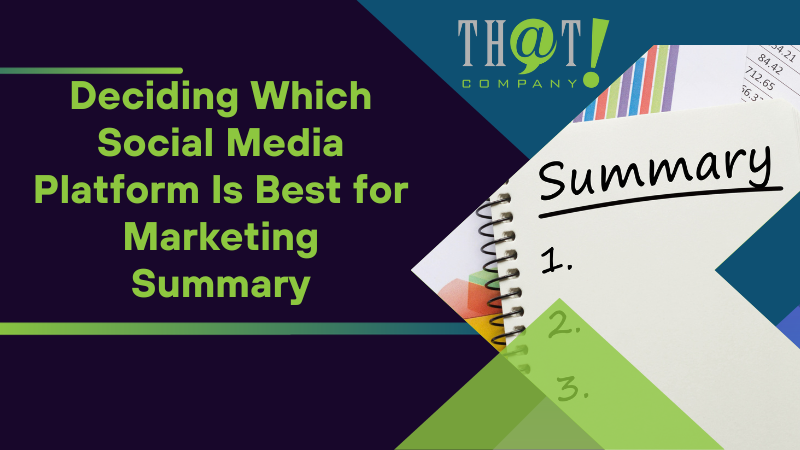
Summary
As we dock back at the harbor, it’s time to reflect on our journey. We’ve navigated the vast ocean of social media marketing, exploring the various islands – the platforms – and understanding how to choose the right ones based on our target audience, marketing goals, budget, and competition. We’ve also shared some seafaring tips to ensure a successful voyage, from maintaining consistency and frequency in posting and creating diverse and engaging content to utilizing analytics and performance tracking tools.
Remember, the journey doesn’t end here. The sea of social media marketing is ever-changing, with new islands emerging and currents shifting. But with the right compass – your understanding of your target audience and marketing objectives – and a seasoned crew – a white label provider like That! Company – you’re well-equipped to navigate any sea. So, set sail, explore, and make waves in the ocean of social media marketing!
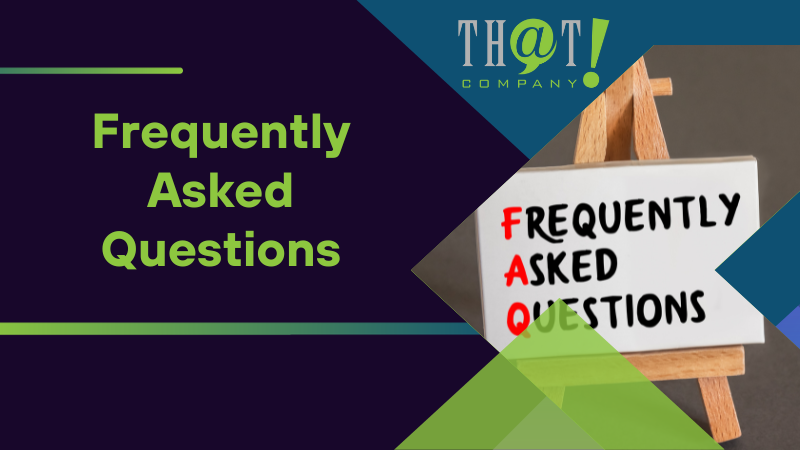
Frequently Asked Questions
What social media platform is good for marketing?
Instagram is considered one of the best social media platforms for marketing due to its potential for audience growth and accurate algorithm. It is expected to grow the most among social media platforms in 2023.
What is the best type of social media marketing?
Influencer marketing is considered one of the best types of social media marketing. An influencer has a devoted following on social media, such as a YouTuber or a blogger.
Which social media channel is best for marketing?
For marketing, Facebook is the most important social media channel for B2C and B2B marketers, as it allows for creating online communities and engagement rather than just chasing followers. Other effective platforms include YouTube, Instagram, LinkedIn, Twitter, TikTok, and Snapchat, each requiring a different approach based on user base, vibes, pros, cons, and content types.
Why is understanding your target audience crucial in social media marketing?
Understanding your target audience is crucial in social media marketing because it allows you to tailor your content to their needs, enhancing the brand reach and meeting marketing goals.
How do demographics influence the choice of social media platforms for marketing?
Demographics significantly impact the selection of social media platforms for marketing, as different age groups and regions have varying preferences and habits regarding social media use.

